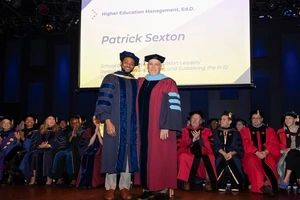Faculty Expert
2020 brought unprecedented challenges to leaders in every profession and field, and educational leaders have been on the frontlines in responding to the pandemic and protests for racial justice. Leaders across the educational spectrum have had to make consequential decisions impacting their entire communities, within a context of great uncertainty, significant political polarization, and few resources to support their work.
However, 2020 was not the first crisis educators have faced, and it certainly won’t be the last. To lead our schools and systems effectively in the 21st century, those who lead within the field of education must be equipped with the mindsets and skills necessary to lead through crises.
Pam Grossman, Dean of the Graduate School of Education, is an expert in preparing educators for real world challenges. Erika James, Dean of the Wharton School, is a leading researcher and scholar in the area of crisis leadership. Together they argue that to be prepared leaders need to consider the necessary crisis leadership practices that should occur before, during, and after a crisis happens.
Grossman and experts from across Penn will explore these and other issues in the Strategic Leadership in Education certificate program, which begins in February.
Here, Grossman and James offer a framework for how you can lead in a crisis building off their experience and Dean James' research:
Before the Crisis
Build Relationships. Education leaders must build strong, high-quality relationships before they need them. If you wait for a moment of crisis to build these strong relationships and then ask your team to jump through the fire with you, you may find yourself jumping alone. Investing in your relationships with people across your institution will provide the best long-term dividends when you face a crisis.
Recognize where talent lies. Leaders must identify where talent lies within their organization, regardless of job titles. Crises frequently demand new talents and skills, and when leaders know their people well, they are better positioned to mobilize the right people quickly when needed. For example, familiarity with online learning technologies and platforms may have been a “nice to have” skill ten months ago. Now, it’s a necessity. Leaders who knew where that particular expertise existed within their organizations, beyond the IT department, were able to quickly call upon those individuals for support, guidance, and leadership roles in helping to develop the skills for other individuals.
During the Crisis
Prioritize your efforts. In a crisis, leaders are bombarded by multiple and conflicting demands. Some leaders feel immense pressure to prioritize the concerns and interests of those who are the most vocal, the proverbial squeaky wheels. However, those who are the most vocal might not be the same as those who are most adversely affected as a result of the crisis. Leaders must concentrate amidst the noise to consider who is being most affected by the crisis and prioritize their work accordingly.
Want to develop your capacity to lead with purpose, confidence, and skill? Learn how with the Strategic Leadership in Education certificate.
While every student is likely to be experiencing some level of stress in the current pandemic, the burdens are not evenly distributed. For example, on college campuses, students argued vociferously about their desire to be on campus; however, for some first generation, low-income students, college housing may have provided the only housing opportunity with reliable internet access. Their needs would need to take priority. Similarly, at the K-12 level, leaders have had to prioritize the needs of younger students or students with special needs, who may not be able to learn easily on a screen, over those for whom remote learning is more feasible, even as parents demanded in-person classes for their high school students.
Such actions, no matter how defensible, will not silence the critics, which is why it is so important to both make the case for decisions and take stock of stakeholders.
Make the Case. Given that crises can force changes both big and small, many of us will likely experience a sense of loss and frustration. These sentiments can be amplified when stakeholders feel that their leaders are not prioritizing the things that they may value the most. Leaders must be in tune with these sentiments and facilitate a change process that helps individuals within the organization understand how the context has changed, what issues and problems are now most relevant, and provide a vision for a better future. To do this, a leader will need to engage in “issue selling,” in which they make a compelling case for where the organization should be focusing its efforts.
Take the example of the college students demanding on-campus housing above. Empathizing with the loss of their imagined college experience that students are experiencing while appealing to their understanding of equity can help higher education leaders make the case for decisions to limit on-campus housing to those most in need of this resource. At the K-12 level, leaders have had to make the case regarding their decision to reopen schools or remain remote, using appeals to data, public health guidance, and the academic and social-emotional needs of children.
Take Stock of Stakeholders. If you’ve followed the advice above, you already see that you cannot make everyone happy during a crisis. By choosing one course of action, leaders face alienating stakeholders who preferred a different decision. During a crisis, leaders must take stock of the various stakeholders that require their attention.
Within each stakeholder group, leaders might want to consider who falls into each of three subcategories: Adversaries, Ambivalent, Advocates. While there may be a temptation to try to focus on adversaries, trying to convert them to your perspective, in fact, leaders may have more influence with those who are currently ambivalent. Converting ambivalent stakeholders into advocates (rather than allowing them to slip into adversaries), can help you build the legitimacy you need to lead effectively through the crisis. Such a strategy requires listening to the concerns of those who are ambivalent about a particular decision or course or action and providing responses that address those concerns.
Know when to look forward. Much of crisis leadership requires leaders to attend to the details of action plans, crisis communications, and execution of strategies. But even within a crisis, leaders can’t stay enmeshed in the weeds forever. Our communities expect us to have a bigger vision and strategy for the future. Once leaders have built a solid and stable structure to manage the crisis and have clarified roles and procedures in ways that are sustainable, leaders can begin to shift some of their focus to the larger, strategic, questions.
For example, while the organization needs to be tending to the emergencies of the day, a leader must also be contemplating the big questions for tomorrow, such as: How will we support students and faculty with the transition back to school? What role will virtual learning play in the future, and how can we take advantage of what we’ve learned through the crisis to create more effective hybrid options? Given the tumultuous nature of the past year, how might we want to rethink our assessment policies and practices?
After the Crisis
Learn from the experience. A crisis can reveal our vulnerabilities. It allows us to see what works well and what doesn’t. Therefore, a crisis can provide a powerful organizational audit of what is working well, and what needs to be improved. While the people within organizations may be eager to move on quickly, effective leaders know the importance of taking time to reflect and learn.
Creating time for a “post-mortem” of various initiatives can help the organization learn and be better prepared for the next crisis. Collecting data from various stakeholders on how they feel their leaders responded to the crisis will reveal the processes and systems that may have been vulnerable to begin with. For example, overwhelmed by the need for rapid-fire communications in earlier crises led some higher education leaders to analyze process and develop stronger communication plans and processes for the future. These processes became invaluable resources in communicating quickly and effectively when the Coronavirus began shutting down college campuses.
Identify innovations. Crises are often so distasteful that people try to get past them as quickly as possible. Leaders may also feel pressure from stakeholders to “return to normal” and not look back. However, going back to normal might mean that you’re going back to a time that is no longer relevant, given all that the crisis has revealed and the innovation that it has forced. Leaders must consider how to take advantage of the experience to identify the innovations that took place and consider which innovations should be sustained in the next chapter of the organization.
For example, in response to remote learning, some schools have created new programs that provide more personalized mentoring to students, ensuring that every student has an adult with whom they are connected. Other schools have placed a renewed focus on policies and practices to support staff well-being. While these initiatives came in response to the crisis, they may be worthwhile sustaining, and scaling, moving forward.
Conclusion
Leading through crisis is rarely fun but despite the challenges, crises provide growth opportunities for both individual leaders and for organizations. A crisis provides a stress test for an organization, providing leaders with an opportunity both to diagnose potential weaknesses, that may not have been apparent in less challenging times, and to create structures and changes that can strengthen the long-term health of a school or college. With strong leadership, people can also come together in a crisis, refocusing their efforts on the highest priorities of an institution. Finally, circumstaces surrounding a crisis can accelerate change, as many education leaders discovered when they needed to turn to online learning almost overnight.
Crisis leadership also provides unlimited learning opportunities for leaders, who will be faced with new challenges but new opportunities as well to learn and grow. Those who hadn’t done the essential work of building relationships and getting to know the people across their schools and organizations have an opportunity to learn more deeply where talent resides and how to forge relationships quickly over shared adversity. Leaders have an opportunity to hone their communications skills, listen more deeply to their constituents, and by necessity, focus on their highest priorities. When it’s impossible to appease all stakeholders, leaders can learn to make peace with fact that not everyone will be happy with a decision and to focus their efforts on making their case and bringing along as many people as possible.
Learning always requires being stretched beyond our current capacities, which is why discomfort so often accompanies our efforts to learn something new. Adapting a crisis leadership mindset can help keep you focused on the growth of both individuals and organizations in the midst of turbulence.

Subscribe to the Educator's Playbook
Get the latest release of the Educator's Playbook delivered straight to your inbox.
Media Inquiries
Penn GSE Communications is here to help reporters connect with the education experts they need.










